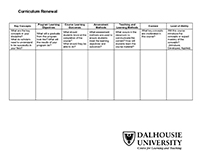Curriculum Renewal Process
The curriculum renewal process can address the following questions
The above is based on adaptations of the Curriculum Innovation and Renewal cycle from the University of Saskatchewan, the Curriculum Review cycle at the University of Calgary, and the model of Curriculum Development process at the University of Guelph.
Each of these questions represents an important stage in the curriculum renewal or design process.
| What is our vision? Where are we going? | Most likely, you have already recognized aspects of your program that you would like to either maintain or change. Perhaps you have a vision for an entirely new program. Some changes will require MPHEC approval and others will need institution-level endorsement. The renewal or design process begins by determining how to articulate your vision and the process required to achieve it. |
|---|---|
| What characteristics does our ideal graduate possess? | Attempting to describe who you hope your students will become can provide perspective on the program goals and help identify the most important pieces of a program. Answering this question often encourages discussion about the key concepts students should understand and be able to apply in the appropriate disciplinary context. |
| What does the program currently have? | In order to make good decision about the direction of a program it is helpful to gather data and begin to synthesize information. You will have the opportunity to consider important elements already foundational to the curriculum, and identify other features you want to embed in the curriculum (like diversity and inclusion). Perhaps there is a content delivery or assessment method you would like to include in the program, like community-engaged learning, blended learning, problem-based learning, online instruction, or collaborative learning. A curriculum map, can clarify how the program is currently delivered and determine the best way to proceed with development. |
| What does the curriculum need? | By interpreting the information, it is possible to identify the curriculum’s strengths, as well as any gaps. This is the stage in which potential modifications are considered in accordance with the over-arching vision and the curriculum map. |
| How will we make it happen? | If desired changes are identified, it is important to create a strategy for incorporating any modifications to the curriculum. At this stage, specific faculty members may wish to take the lead to adopt or adapt certain curricular elements. |
| Is it working? | If you have modified your curriculum it is a good idea to consider the successes and determine how well the changes are working. Devise an assessment strategy, including desired outcomes, and a way to measure them. |
Download Questions [PDF - 59 KB]


